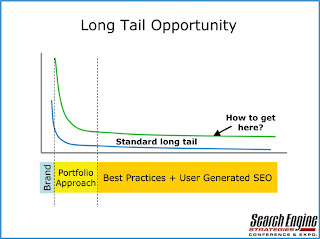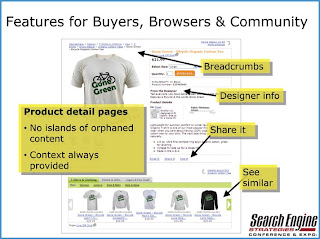Gotta love UGC – its what makes it a 2.0 world 🙂 Let’s see what the experts have to say!!
Panelists:
Rebecca Lieb, ClickZ
Mehdi Maghsoodnia, CafePress
Benu Aggarwal, Milestone Internet Marketing
Kurt Krake, Bazaarvoice
Cafepress was up first. They focus on the longtail and love user generated SEO. Cafepess also manages the portfolio and also the branding aspects of search. Brand is most searched, and competitive and portfolio is the middle of the tail:

But everyone knows the conversions are in the longtail. How do you maximize the longtail? Mehdi said its all about Taxonomy – which is the art / science of making things on your website simple and easy to find. Tags and breadcrumbs are a huge part of that.
You also have users tagging content – called Folksonomy. The community helps to create these longtails too, with the way they are labeling your content. This is why its a good idea to Tag cloud , it can boost your pages.
If you have a large site, that can be a daunting task, though.
ASK: What products are relevant? How does the design sell? Is it bought and returned?
Then implement some tools for optimization
- Breadcrumb links
- Designer info
- “Share it” or “tell a friend” option
- See similiar
- Product detail pages – no islands of orphaned content and context always provided

Also remember those Reseller Shops – resellers should be able to SEO their own shops. With text intros, section descriptions, etc.
Measure traffic sources, volume, and engines, to make sure you’re on track for success.
Look at the term, the number of searches, and the number of orders. Compare these together so you can constantly improve ROI.
Next up we had Benu Aggarwal with Milestone Internet Marketing – discussing how you can take user reviews and make them convert.
Why are customer reviews important?
Because in a recent Social shopping study of 1200 consumers, 78% of shoppers spend more than 10 minutes reading reviews, which means they are a significant buying consideration.
Optimize your reviews
Reviews have an impact on conversion. They increase site traffic through SEO, and help form a trust factor with potential buyers. Conversions on one case study went from below 10% to a 70% increase!
Other significant conversion factors
Strategic placement. The ways the reviews are presented are significant. Look at TripAdvisor.com – it has huge conversions because the way the reviews are shown.
Place your reviews ABOVE the fold. Do one line synapsis and make them clickable if you can. Allow customers to post video too.
Offer incentives to post reviews.
Define your website taxonomy. Classify your products on paper. Taxonomy is the science and art of classifying a broad range of things.
Define website architecture. Create a logical flow of the website to make everything easy for the visitor.
Have a powerful search box, make sure every page of your site has unique selling points, and put your most important conversion elements above the scroll.
Best practices:
- Shorter click through path
- Multiple point entry
- Category index pages that act more like a site map and provide target page within 2 clicks
- Using keywords in URL
- Use java and ajax sparingly
- Bread crumb trails
- Use CSS for layout
- Use server-side database
- If possible have video
Next up we have Kirk Krake with Bazzarvoice, and he discussed natural search and how product reviews enhance that.
Kirk discussed a study based on 21 retail brands, Home Depot included. The study was designed to answer the question “What was the impact of reviews on natural search traffic, conversion, and average order size?”
77% of purchasers use product reviews when shopping online
Want a random reason reviews are cool? Consumers will misspell your product or service, but that’s ok because sometimes you don’t get all the misspellings or look unprofessional if you do. Review misspellings help people find you or your product even further across the web.
The higher the competition for generic terms, the worse the conversion. Stay away from generic and go for the long tail!!!
Look at your Google trends graphs to see how those long tails really factor out.
Consider segmented display for ratings and reviews. You can do a product focused page but a reviews focused page will probably get you better conversions.
Also, if you segment your content it improves the user experience. Xbox 360 platinum system search on Google brings the product. Xbox 360 platinum reviews brings the UGC and opinions.
Google’s average keyword length is 2.35 words per query. Reviews will bring highly converting traffic because they average 3.5 keywords, so you are getting further down the long tail.
Results:
- Product searches frequently contain a retailer name – ie. dell laptops not just laptops
- Reviews pages were more effective than product pages at capturing new customer searches
- Reviews drive more revenue per referral – 2.1% vs 1.2%
- AND they make the average order higher
You can get the rest of the study and others here: http://www.bazaarvoice.com/whitePapers.html
Questions:
How do you give incentive for reviews? How do you get people to come BACK to the site to review the product? Send out emails with top 5 products, suggest they review and offer a discount on the next purchase.
What about the crazy irate customer? Or the competitor putting negativity about you as a customer review? Moderate your stuff! Use alerts. Many sites have tools in place to stop this. If its on your website you can moderate the comments. If its on a 3rd party site don’t sweat it too much, focus on getting more positive reviews. Cafepress also looks at controversial comments and judges them on a case by case basis. They remove really bad comments.
What about Yelp, citysearch, these 3rd party sites that are bashing you? Just try to get positive reviews too. The public understands. Ask your friends and family and best clients to post positive things.
What is the best incentive to post reviews? Email is usually best, offer a free drink, discount, coupon. Offer them a repeat purchase. Also offer contests by email. Give people a “top reviewer” badge. If someone submits one review, ask them to review other products they bought.
What are the best locations in the website to ask people to review? In retail its mostly about receiving the product when promised, so email again is best. My thoughts for the service industry would be to offer the review option when the deal closes, or when the service is performed.
What about other UGC? People want to belong. Give them a sense of social connection, and of ownership, then they will give you the UGC you want. Some people don’t want discounts they want their voice heard. Embrace that and let them speak. Try the ask and answer product by Thingz. Have people tell stories about the product or service too.
How can you generate UGC that’s not on your site? Embed customer’s utube videos on your website. Oohh maybe make a client central or something where you just feature them and all the UGC they’ve put online about your product. Ask your customer to upload video, stories, experiences and its ok if it has grammar errors etc.
I think I’ll encourage clients on the chamber blogs etc by linking to the speakers on yelp.com for reviews. Then hopefully more of Orange County local businesses will start reviewing eachother.



